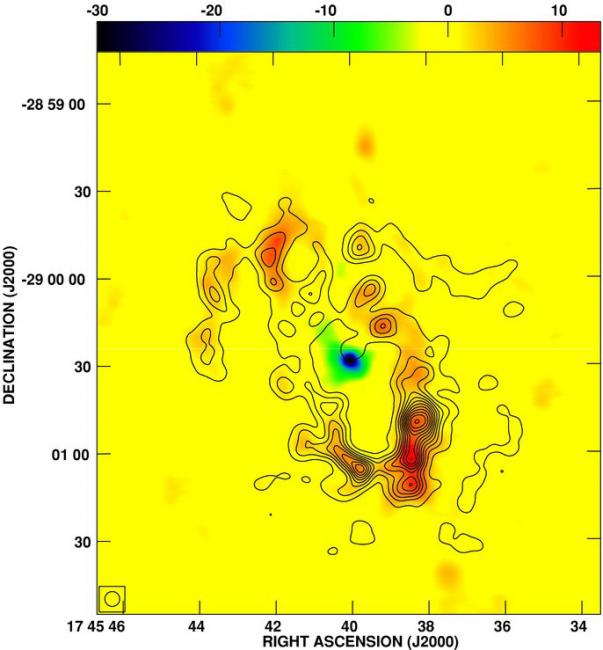
A false color image of the Circumnuclear Disk ringing the supermassive black hole at the center of our galaxy. The contours and colors correspond to the intensity of radiation from HCN gas; the black hole is located near the bright blue spot inside the ring.
The center of our Milky Way galaxy is located about twenty-five thousand light years from earth, in the direction of the constellation of Sagittarius. It is invisible to us in optical light because of extensive amounts of intervening dust, but radiation at other wavelengths, including the infrared and radio, can penetrate the veiling material. Even though it is far away, the Galactic Center plays an important part in earth's story. The solar system orbits around the center once every few hundred million years, and astronomers think the origin, evolution, and perhaps future of the entire Milky Way (including the region where the solar system resides) are reflected and perhaps partly determined by the properties of the Galactic Center region. Of course astronomers are also anxious to test their basic understanding of the bizarre nature of black holes themselves by studying this one - the massive black hole that is by far the closest to us.
Surrounding this supermassive black hole, at a distance of about 6 light-years, is a clumpy circumnuclear ring of material called the Circumnuclear Disk (CND). Astronomers wonder who ordered this odd structure, and are also puzzled to see it because such a ring-like object should quickly fragment and disappear. SAO astronomers Maria Montero-Castano and Paul Ho, together with former Harvard graduate student Robin Herrnstein, used the Smithsonian's Submillimeter Array (SMA) to obtain the first set of high quality images of the CND in dense gas as traced by the molecules hydrogen cyanide (HCN) and carbon monosulfide (CS).
The astronomers find that the CND is more like a necklace: a string of clumps around the supermassive black hole, with each clump containing several thousands of solar masses of gas. Furthermore, they find that the clumps are dense enough to be able to hold together against typical disruptive forces. Their analysis of the gas motions in and around the ring suggests that material is falling into the CND, while gas from the CND is spiraling in towards the black hole at the center. Their results are significant because they imply that the CND is not a transient structure, and that it plays some long-lasting role in the story of our galaxy's center.